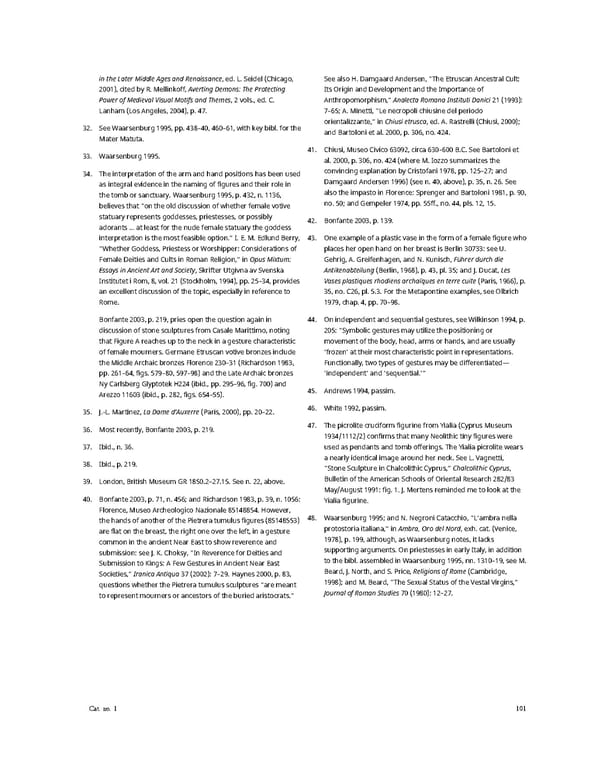in the Later Middle Ages and Renaissance, ed. L. Seidel (Chicago, See also H. Damgaard Andersen, “The Etruscan Ancestral Cult: 2001), cited by R. Mellinkoff, Averting Demons: The Protecting Its Origin and Development and the Importance of Power of Medieval Visual Motifs and Themes, 2 vols., ed. C. Anthropomorphism,”Analecta Romana Instituti Danici 21 (1993): Lanham (Los Angeles, 2004), p. 47. 7–65; A. Minetti, “Le necropoli chiusine del periodo 32. SeeWaarsenburg 1995, pp. 438–40, 460–61, with key bibl. for the orientalizzante,” in Chiusi etrusca, ed. A. Rastrelli (Chiusi, 2000); Mater Matuta. andBartoloni et al. 2000, p. 306, no. 424. 33. Waarsenburg 1995. 41. Chiusi, Museo Civico 63092, circa 630–600 B.C. See Bartoloni et al. 2000, p. 306, no. 424 (where M. Iozzo summarizes the 34. The interpretation of the arm and hand positions has been used convincing explanation by Cristofani 1978, pp. 125–27; and as integral evidence in the naming of figures and their role in Damgaard Andersen 1996) (see n. 40, above), p. 35, n. 26. See the tomb or sanctuary. Waarsenburg 1995, p. 432, n. 1136, also the impasto in Florence: Sprenger and Bartoloni 1981, p. 90, believes that “on the old discussion of whether female votive no. 50; and Gempeler 1974, pp. 55ff., no. 44, pls. 12, 15. statuary represents goddesses, priestesses, or possibly 42. Bonfante 2003, p. 139. adorants … at least for the nude female statuary the goddess interpretation is the most feasible option.” I. E. M. Edlund Berry, 43. One example of a plastic vase in the form of a female figure who “Whether Goddess, Priestess or Worshipper: Considerations of places her open hand on her breast is Berlin 30733: see U. Female Deities and Cults in Roman Religion,” in Opus Mixtum: Gehrig, A. Greifenhagen, and N. Kunisch, Führer durch die Essays in Ancient Art and Society, Skrifter Utgivna av Svenska Antikenabteilung (Berlin, 1968), p. 43, pl. 35; and J. Ducat, Les Institutet i Rom, 8, vol. 21 (Stockholm, 1994), pp. 25–34, provides Vases plastiques rhodiens archaïques en terre cuite (Paris, 1966), p. an excellent discussion of the topic, especially in reference to 35, no. C26, pl. 5.3. For the Metapontine examples, see Olbrich Rome. 1979, chap. 4, pp. 70–98. Bonfante 2003, p. 219, pries open the question again in 44. On independent and sequential gestures, see Wilkinson 1994, p. discussion of stone sculptures from Casale Marittimo, noting 205: “Symbolic gestures may utilize the positioning or that Figure A reaches up to the neck in a gesture characteristic movement of the body, head, arms or hands, and are usually of female mourners. Germane Etruscan votive bronzes include ‘frozen’ at their most characteristic point in representations. the Middle Archaic bronzes Florence 230–31 (Richardson 1983, Functionally, two types of gestures may be differentiated— pp. 261–64, figs. 579–80, 597–98) and the Late Archaic bronzes ‘independent’ and ‘sequential.’” Ny Carlsberg Glyptotek H224 (ibid., pp. 295–96, fig. 700) and 45. Andrews 1994, passim. Arezzo 11603 (ibid., p. 282, figs. 654–55). 35. J.-L. Martinez, La Dame d’Auxerre (Paris, 2000), pp. 20–22. 46. White 1992, passim. 36. Most recently, Bonfante 2003, p. 219. 47. The picrolite cruciform figurine from Yialia (Cyprus Museum 1934/1112/2) confirms that many Neolithic tiny figures were 37. Ibid., n. 36. used as pendants and tomb offerings. The Yialia picrolite wears 38. Ibid., p. 219. a nearly identical image around her neck. See L. Vagnetti, “Stone Sculpture in Chalcolithic Cyprus,” Chalcolithic Cyprus, 39. London, British Museum GR 1850.2–27.15. See n. 22, above. Bulletin of the American Schools of Oriental Research 282/83 May/August 1991: fig. 1. J. Mertens reminded me to look at the 40. Bonfante 2003, p. 71, n. 456; and Richardson 1983, p. 39, n. 1056: Yialia figurine. Florence, Museo Archeologico Nazionale 85148854. However, the hands of another of the Pietrera tumulus figures (85148553) 48. Waarsenburg 1995; and N. Negroni Catacchio, “L’ambra nella are flat on the breast, the right one over the left, in a gesture protostoria italiana,” in Ambra, Oro del Nord, exh. cat. (Venice, common in the ancient Near East to show reverence and 1978), p. 199, although, as Waarsenburg notes, it lacks submission: see J. K. Choksy, “In Reverence for Deities and supporting arguments. On priestesses in early Italy, in addition Submission to Kings: A Few Gestures in Ancient Near East to the bibl. assembled in Waarsenburg 1995, nn. 1310–19, see M. Societies,” Iranica Antiqua 37 (2002): 7–29. Haynes 2000, p. 83, Beard, J. North, and S. Price, Religions of Rome (Cambridge, questions whether the Pietrera tumulus sculptures “are meant 1998); and M. Beard, “The Sexual Status of the Vestal Virgins,” to represent mourners or ancestors of the buried aristocrats.” Journal of Roman Studies 70 (1980): 12–27. Cat. no. 1 101
 Ancient Carved Ambers in the J. Paul Getty Museum Page 110 Page 112
Ancient Carved Ambers in the J. Paul Getty Museum Page 110 Page 112